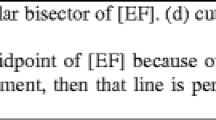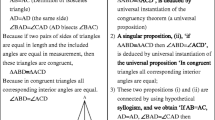Abstract
Having high school students prove geometrical propositions became the norm in the United States with the reforms of the 1890's — when geometry was designated as the place for students to learn the ‘art of demonstration.’ A custom of asking students to produce and write proofs in a ‘two-column format’ of statements and reasons developed as the teaching profession responded to the demands of reform. I provide a historical account for how proving evolved as a task for students in school geometry, starting from the time when geometry became a high school subject and continuing to the time when proof became the centerpiece of the geometry curriculum. I use the historical account to explain how the two-column proof format brought stability to the course of studies in geometry by making it possible for teachers to claim that they were teaching students how to prove and for students to demonstrate that their work involved proving. I also uncover what the nature of school geometry came to be as a result of the emphasis in students' learning to prove by showing that students' acquisition of a generic notion of proof was made possible at the expense of reducing students' participation in the development of new ideas. I draw connections between that century-old reform and current reform emphases on reasoning and proof. I use observations from history to suggest that as we carve a place for proof in present-day school mathematics we must be leery of isolating issues of proving from issues of knowing.
Similar content being viewed by others
REFERENCES
Baker, J.: 1969, 'Minority report to the national council of education', in National Education Association, Report of the Committee on secondary school studies, Arno Press, New York, pp. 56–59. (Original work published 1893)
Ball, D.L. and Bass, H.: 2000, 'Making believe: The collective construction of public mathematical knowledge in the elementary classroom', in D. Phillips (ed.), Constructivism in Education: Yearbook of the National Society for the Study of Education, University of Chicago Press, Chicago, pp. 193–224.
Beman, W. and Smith, D.E.: 1899, New Plane and Solid Geometry, Ginn, Boston.
Carson, G.: 1913, Essays on Mathematical Education, Ginn, London.
Chauvenet, W.: 1870, A Treatise on Elementary Geometry with Appendices containing a Collection of Exercises for Students and an Introduction to Modern Geometry, Lippincot, Philadelphia.
Chauvenet, W.: 1898, Treatise on Elementary Geometry, W. Byerly (ed.), Lippincot, Philadelphia. (Original work published 1887)
Davies, C.: 1850, The Logic and Utility of Mathematics, with the Best Methods of Instruction Explained and Illustrated, Barnes, New York.
Dewey, J.: 1903, 'The psychological and the logical in teaching geometry', Educational Review 25, 387–399.
Donoghue, E.: 1987, The Origins of a Professional Mathematics Education Program at Teachers College, Unpublished doctoral dissertation. Columbia University Teachers College.
Eliot, C. et al.: 1969, 'Report of the Committee of Ten to the National Education Association', in National Education Association, Report of the Committee on secondary school studies, Arno Press, New York, pp. 3–5. (Original work published 1893)
Eliot, C.: 1905, 'The fundamental assumptions in the report of the Committee of Ten (1893)', Educational Review 30, 325–343.
Fawcett, H.: 1938, The Nature of Proof - The National Council of Teachers of Mathematics Thirtheenth Yearbook, Bureau of Publications of Teachers College, Columbia University, New York.
Greenleaf, B.: 1858, Elements of Geometry with Practical Applications to Mensuration, Robert Davis, Boston.
Halsted, G.: 1893, 'The old and the new geometry', Educational Review 6, 144–157.
Harris, W.T.: 1894, 'The committee of ten on secondary schools', Educational Review 7, 1–10.
Hilbert, D.: 1971, Foundations of Geometry, L. Unger, Trans., P. Bernays, Rev.. Open Court, La Salle, IL. (Original work published in German in 1899)
Hill, F.: 1895, 'The educational value of mathematics', Educational Review 9, 349–358.
Howson, G.: 1982, A History of Mathematics Education in England, Cambridge University Press, Cambridge.
Jones, P.: 1944, 'Early American geometry', The Mathematics Teacher 37, 3–11.
Kilpatrick, J.: 1992, 'A history of research in mathematics education', in D. Grouws (ed.), Handbook of Research in Mathematics Teaching and Learning, Macmillan, New York, pp. 3–38.
Kliebard, H.: 1986, The Struggle for the American Curriculum 1893-1958, Routledge and Kegan Paul, Boston.
Kline, M.: 1965, 'View of the new math', in E. Moise, A. Calandra, R. Davis, M. Kline and H. Bacon (eds.), “New Math”, (Council for Basic Education, Washington, DC, pp. 13–16.
Krug, E.: 1964, The Shaping of the American High School, Harper and Row, New York.
Lakatos, I.: 1976, Proofs and Refutations: The Logic of Mathematical Discovery, J. Worrall and E. Zahar (eds.), Cambridge University Press, Cambridge.
Lakatos, I.: 1978, 'A renaissance of empiricism in the recent philosophy of mathematics?' in J. Worrall and G. Currie (eds.), Imre Lakatos. Mathematics, Science and Epistemology: Philosophical Papers, Cambridge University Press, Cambridge, Vol. 2, pp. 24–42. (Original work published in 1967)
Legendre, A.-M.: 1819, Elements of Geometry, J. Farrar (ed. and trans.), Hilliard and Metcalf, Cambridge, New England.
Legendre, A.-M.: 1841, Elements of Geometry, J. Farrar (ed. and trans.), Hilliard Gray, Boston.
Legendre, A.-M.: 1848, Elements of Geometry and Trigonometry, D. Brewster (trans.), C. Davies (rev. and ed.), Barnes, New York.
Moore, E.H.: 1926, 'On the foundations of mathematics', in C. Austin, H. English, W. Betz, W. Eells and F. Touton (eds.), A General Ssurvey of Progress in the Last Twenty-Five Years: First Yearbook, National Council of Teachers of Mathematics, Washington, DC, pp. 32–57. (Original speech delivered in 1902)
NCTM: 2000, Principles and Standards for School Mathematics, Author, Reston, VA.
Newcomb, S. et al.: 1893, 'Reports of the conferences: Mathematics', in National Education Association, Report of the Committee on secondary school studies, Arno Press, New York, pp. 104–116. (Original work published 1893)
Nightingale, A. et al.: 1899, 'Report of the Committee on College entrance requirements', in National Education Association, Report of Committee on College Entrance Requirements - July, 1899, NEA, Chicago, pp. 5–49.
Playfair, J.: 1860, Elements of Geometry; Containing the First Six Books of Euclid, with a Supplement on the Quadrature of the Circle, and the Geometry of Solids. To which are Added Elements of Plane and Spherical Trigonometry, Collins and Hannay, New York. (Original work published 1795)
Poincaré, H.: 1899, 'La logique et l'intuition dans la science mathématique et dans l'enseignement', L'Enseignement Mathématique 1, 157–162
Quast, W.G.: 1968, Geometry in the High Schools of the United States: An Historical Analysis from 1890 to 1966, Unpublished doctoral dissertation. Rutgers - The State University of New Jersey, New Brunswick.
Rav, Y.: 1999, 'Why do we prove theorems?' Philosophia Mathematica 7, 5–41.
Ravitch, D.: 2000, Left Back: A Century of Failed School Reforms, Simon and Shuster, New York.
Richards, E.: 1892, 'Old and new methods in elementary geometry', Educational Review 3, 31–39.
Schoenfeld, A.: 1987, 'On having and using geometrical knowledge', in J. Hiebert (ed.), Conceptual and Procedural Knowledge: The Case of Mathematics, Erlbaum, Hillsdale, NJ, pp. 225–264.
Schultze, A.: 1912, The Teaching of Mathematics in Secondary Schools, MacMillan, New York.
Schultze, A. and Sevenoak, F.: 1901, Plane and Solid Geometry, MacMillan, New York.
Schulze, A. and Sevenoak, F.: 1913, Plane Geometry, A. Schultze, (rev.), MacMillan, New York.
Shibli, J.: 1932, Recent Developments in the Teaching of Geometry, Author, State College, PA.
Shutts, G.: 1892, 'Old and new methods in geometry', Educational Review 3, 264–266.
Simson, R.: 1756, The Elements of Euclid, viz. the First Six Books together with the Eleventh and Twelfth. In this edition, the Errors, by which Theon, or others, have long ago vitiated these Books, are corrected, and some of Euclid's Demonstrations are Restored, Foulis, Glasgow.
Sizer, T.: 1964, Secondary Schools at the Turn of the Century, Yale University Press, New Haven.
Slaught, H. et al.: 1912, 'Final report of the National Committee of Fifteen on geometry syllabus', The Mathematics Teacher 5, 46–131.
Smith, D.E.: 1911, The Teaching of Geometry, Ginn, Boston.
Smith, E.R.: 1909, Plane Geometry Developed by the Syllabus Method, American Book Co, New York.
Stanic, G.M.A.: 1983, Why Teach Mathematics? A Historical Study of the Justification Question, Unpublished doctoral dissertation. University of Wisconsin, Madison.
Stanic, G.M.A.: 1987, 'Mathematics education in the United States at the beginning of the twentieth century', in T. Popkewitz (ed.), The Formation of School Subjects: The Struggle for Creating an American Institution, Falmer, New York, pp. 145–175.
Wells, W.: 1887, The Elements of Geometry, Leach, Shewell, and Sanborn, Boston.
Wells, W.: 1908, New Plane and Solid Geometry, Heath, Boston.
Wentworth, G.: 1878, Elements of Geometry, Ginn and Heath, Boston.
Wentworth, G.: 1888, A Text-Book of Geometry, Ginn, Boston.
Wentworth, G.: 1899, Plane and Solid Geometry, Ginn, Boston.
Young, J.W.A. et al.: 1899, 'Report of the Committee of the Chicago section of the American Mathematical Society', in National Education Association, Report of Committee on College Entrance Requirements - July, 1899, NEA, Chicago, pp. 135–149.
Young, J.W.A.: 1906, The Teaching of Mathematics in the Elementary and the Secondary School, Longmans, Green, and Co, New York.
Author information
Authors and Affiliations
Rights and permissions
About this article
Cite this article
Herbst, P.G. Establishing a custom of proving in american school geometry: evolution of the two-column proof in the early twentieth century. Educational Studies in Mathematics 49, 283–312 (2002). https://doi.org/10.1023/A:1020264906740
Published:
Issue Date:
DOI: https://doi.org/10.1023/A:1020264906740




